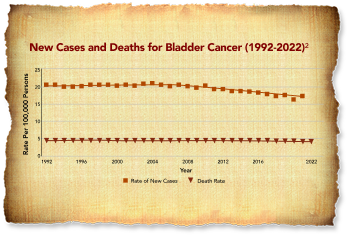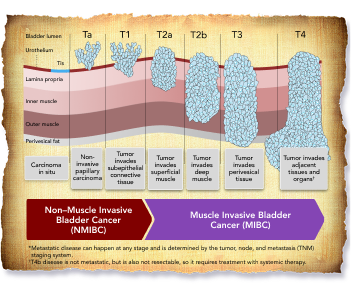Epidemiology of Bladder Cancer IN THE UNITED STATES
Estimates for 2025
84,870 new cases of bladder cancer will be diagnosed.1
Bladder cancer is the 9th most common cancer.2
Bladder cancer is more prevalent in older adults, and it is projected that the population ages 65 years and over will increase by 40% in the next 20 years.2-4
FOR OVER 3 DECADES, BLADDER CANCER–RELATED MORTALITY HAS REMAINED RELATIVELY STAGNANT2
Age-adjusted death rates have been falling on average 0.9% each year over 2013-2022.2
The median age at diagnosis is 73.2


The Development and Progression of Bladder Cancer
Bladder cancer typically develops in the urothelium and can spread to the bladder muscle, eventually leading to metastasis.5-7*

References:
Bladder cancer. American Cancer Society. Accessed February 12, 2025. https://www.cancer.org/cancer/types/bladder-cancer.html
Cancer stat facts: bladder cancer. National Cancer Institute: Surveillance, Epidemiology, and End Results Program. Accessed February 12, 2025. https://seer.cancer.gov/statfacts/html/urinb.html
US Census Bureau. Demographic turning points for the United States: population projections for 2020 to 2060. Accessed February 12, 2025. Available at: https://www.census.gov/content/dam/Census/library/publications/2020/demo/p25-1144.pdf
Weir HK, Thompson TD, Stewart SL, White MC. Cancer incidence projections in the United States between 2015 and 2050. Prev Chronic Dis. 2021;18:E59. Published June 10, 2021. doi:10.5888/pcd18.210006
Saginala K, Barsouk A, Aluru JS, Rawla P, Padala SA, Barsouk A. Epidemiology of bladder cancer. Med Sci (Basel). 2020;8(1):15. doi:10.3390/medsci8010015
Kanmalar M, Abdul Sani SF, Kamri NINB, et al. Raman spectroscopy biochemical characterisation of bladder cancer cisplatin resistance regulated by FDFT1: a review. Cell Mol Biol Lett. 2022;27(1):9. doi:10.1186/s11658-022-00307-x
Batista R, Vinagre N, Meireles S, et al. Biomarkers for bladder cancer diagnosis and surveillance: a comprehensive review. Diagnostics (Basel). 2020;10(1):39. doi:10.3390/diagnostics10010039
Referenced with permission from the NCCN Clinical Practice Guidelines in Oncology (NCCN Guidelines®) for Bladder Cancer V7.2024.© National Comprehensive Cancer Network, Inc. 2025. All rights reserved. Accessed March 10, 2025. To view the most recent and complete version of the guideline, go online to NCCN.org.
Elferink PO, Witjes JA. Blue-light cystoscopy in the evaluation of non-muscle-invasive bladder cancer. Ther Adv Urol. 2014;6(1):25-33. doi:10.1177/1756287213510590
Kim LHC, Patel MI. Transurethral resection of bladder tumour (TURBT). Transl Androl Urol. 2020;9(6):3056-3072. doi:10.21037/tau.2019.09.38
Patel VG, Oh WK, Galsky MD. Treatment of muscle-invasive and advanced bladder cancer in 2020. CA Cancer J Clin. 2020;70(5):404-423. doi:10:3322/caac.21631
NCCN makes no warranties of any kind whatsoever regarding their content, use or application and disclaims any responsibility for their application or use in any way.